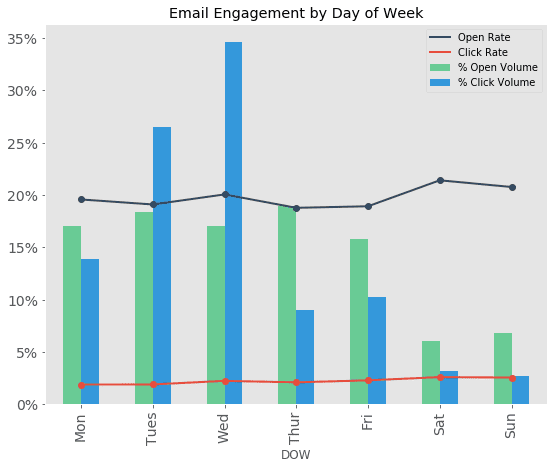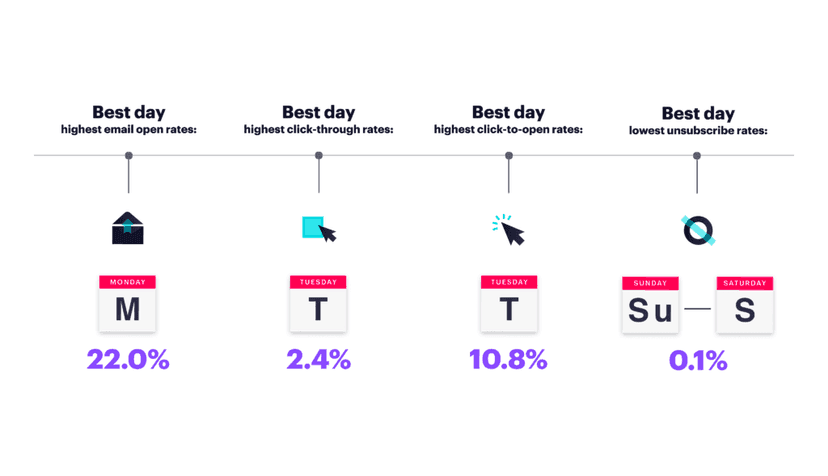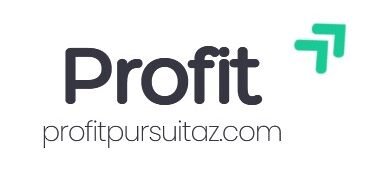Best Day for Email Marketing: Boost Open Rates Now
Email marketing needs perfect timing to be effective. Sending emails on the right day can increase engagement.
Finding the best day to send emails is crucial for any business. Timing can make a big difference in open rates and responses. The best day for email marketing is not just about picking a day randomly. It’s about understanding your audience’s habits and preferences.
Different industries have different peak days, and your audience’s time zone matters too. Research shows that certain days lead to higher engagement. This can boost your campaign’s success significantly. Knowing the best day can help you connect better with your audience and make your email strategy more effective. Let’s explore what makes a particular day the best for email marketing.

Credit: optinmonster.com
Choosing The Optimal Day
Choosing the optimal day for email marketing can boost engagement. Timing plays a crucial role in reaching your audience effectively. Understanding when your subscribers are most active helps in crafting a successful email campaign. Let’s explore the best days for email marketing.
Weekday Vs Weekend
Sending emails during weekdays often yields better results. People check emails more frequently on workdays. Mondays can be hectic, making mid-week a better choice. Wednesdays and Thursdays often show higher open rates. Weekends might seem ideal, but engagement tends to drop. People usually relax and disconnect from work-related emails.
Industry-specific Trends
Different industries have unique patterns. B2B emails often perform well on weekdays. Professionals are more focused on work-related content. B2C emails might see success during weekends. Consumers have more leisure time to browse offers. Understanding your industry’s trends is vital. Tailor your approach based on these insights for better results.

Credit: www.emailonacid.com
Timing Matters
Have you ever sent an email and wondered why no one responded? The timing of your email could be the key factor. Sending an email at the right moment can make all the difference in engagement. Picking the best day and time requires some thought and strategy.
Morning Vs Afternoon
Choosing between morning and afternoon can be tricky. Emails sent in the morning tend to catch people when they’re fresh and focused. They’re more likely to read through your content before the hustle of the day kicks in.
On the other hand, afternoon emails might catch recipients during a lull. After lunch, people often check their emails again. This can be a prime opportunity to grab their attention.
Think about your own habits. Do you find yourself more attentive in the morning or after lunch? Your answer might guide your strategy.
Time Zone Considerations
Time zones can be a hidden factor in email marketing success. Sending an email at 9 AM in New York means it arrives at 6 AM in Los Angeles. Your West Coast audience might miss your message entirely.
To tackle this, segment your list by time zone. Send emails at optimal times for each region. This ensures your message lands when your audience is most receptive.
Consider tools that help automate this process. They can help you schedule emails based on recipient location, maximizing your reach.
Have you ever received an email at an odd hour and ignored it? Reflect on how timing can influence your own actions and apply it to your strategy.
Using the right timing can turn your email marketing from a shot in the dark to a precision-targeted campaign. What changes will you make to your email schedule?
Analyzing Audience Behavior
Email marketing thrives on understanding audience behavior. Knowing when subscribers engage helps optimize send times. Analyze patterns to boost open rates and engagement.
Understanding Subscriber Habits
Subscribers have different habits. Some check emails in the morning. Others prefer evenings. Track these preferences. Use analytics tools to gather data. Check peak engagement times. Consider weekdays versus weekends. Identify trends to tailor your strategy.
Cultural Influences On Engagement
Cultural factors impact engagement. Holidays affect attention. Some regions have specific days for leisure. This alters email activity. Research cultural norms. Adapt your schedule accordingly. Respect local traditions. Align your campaign with cultural practices.
Testing And Experimentation
Testing and experimentation play a critical role in email marketing success. The right day to send emails can impact engagement rates. Discovering this day requires careful testing and analysis. Using different strategies helps in understanding audience behavior better.
A/b Testing Strategies
A/B testing is a valuable technique in email marketing. It involves sending two versions of an email to see which performs better. Change one element at a time, like the send day. This helps identify patterns that resonate with your audience. Choose a sample size that represents your entire audience for accuracy. Consistency in testing ensures reliable data.
Evaluating Results
After running tests, evaluating results is essential. Look at open rates, click-through rates, and conversions. Compare these metrics for different days. This analysis helps you pinpoint the best day for your audience. Document your findings for future reference. Continuous evaluation refines your email marketing strategy over time.
Tools To Enhance Open Rates
Email marketing is effective. But success depends on open rates. To improve these rates, use the right tools. They help automate tasks and analyze data. This section explores tools for better email performance.
Automation Software
Automation software saves time and boosts efficiency. It schedules emails for the best times. These tools personalize content to engage readers. They also segment audiences based on behavior and preferences. Popular options include Mailchimp and Constant Contact.
Analytics Platforms
Analytics platforms provide insights into email performance. They track open rates and click-throughs. This data helps refine future campaigns. Google Analytics and Litmus are popular choices. They help understand what content works best. Use these insights to improve email strategies.
Crafting Engaging Subject Lines
Choosing the best day for email marketing boosts engagement. Crafting subject lines that capture attention increases open rates. Mondays and Thursdays often see higher response rates.
Crafting engaging subject lines is crucial for the success of your email marketing campaign. A compelling subject line grabs attention and encourages recipients to open your email. It’s the first impression your audience gets, so make it count. Think of your own experience—how many emails do you ignore simply because their subject lines don’t entice you? Let’s dive into practical strategies to create subject lines that resonate.Importance Of Personalization
Personalization can transform your subject line from ordinary to outstanding. Imagine receiving an email that mentions your name or references a recent purchase. It immediately feels more relevant and intriguing. Using personalization makes your audience feel valued. It shows you’re paying attention to their preferences. Consider segmenting your email list based on behavior or demographics. Tailored subject lines for different groups can increase open rates. Personalized messages speak directly to the recipient’s needs and interests. This approach not only boosts engagement but also builds stronger connections with your audience.Using Actionable Language
Actionable language prompts your audience to take immediate action. It’s all about creating urgency and excitement. Words like “Discover”, “Try”, or “Join” can ignite curiosity. These words suggest there’s something beneficial awaiting them. Think about the last time you received a subject line that made you want to click right away. Often, it’s the promise of something exciting or useful. Use direct and clear language that conveys value. Invite your readers to engage with your content. Ask yourself, what action do you want your audience to take? Match your subject line to that desired action. Clear intentions lead to better results. Remember, crafting engaging subject lines requires creativity and understanding of your audience. Test different approaches and learn from what works best. Your subject line is the gateway to your content, make sure it invites and intrigues.Content Quality And Relevance
Choosing the best day for email marketing boosts engagement. Content quality and relevance play vital roles. Engaging emails, sent on the right day, capture attention and drive action.
Email marketing can be a powerful tool, but its success hinges significantly on content quality and relevance. Imagine sending out an email that your audience eagerly opens, only to find the content doesn’t meet their expectations or needs. The result? Disappointment and a quick click to the delete button. To ensure your emails resonate with your audience, it’s crucial to create content that is not only well-crafted but also relevant to their interests and needs. Here’s how you can make sure your email content hits the mark.Aligning Content With Audience Needs
Understanding your audience is key. Have you ever received an email that seemed to speak directly to you, addressing your current situation or needs? That level of connection is what you should aim for. Start by segmenting your email list based on demographics, past interactions, or purchase history. This allows you to tailor content specifically to different groups. For instance, if you run a bookstore, you might send different recommendations to young adults than you would to retirees. Ask yourself: What does my audience care about today? Is it a new product, a solution to a common problem, or perhaps a piece of news that impacts their industry? By aligning your content with these interests, you keep your audience engaged and coming back for more.Balancing Information And Promotion
Striking the right balance between informational content and promotional messages is an art. If your emails are too promotional, they might come off as spam. On the other hand, if they’re too informational, you might miss out on driving conversions. Consider using a ratio of 80/20, where 80% of your content is informative and 20% is promotional. This approach ensures that your emails provide value while still promoting your products or services. Think about a recent email you opened that was packed with useful tips or insights. Wasn’t it refreshing to learn something new before being presented with a special offer? This balance keeps your audience engaged and more receptive to your promotions. In your next email campaign, focus on how you can provide value first, and promote second. Are your emails offering insights, solving problems, or bringing joy? If yes, you’re on the right path.Building Consistent Schedules
Creating a consistent schedule is vital for successful email marketing. Regularity helps build trust with your audience. People expect emails at certain times. Meeting these expectations increases engagement. It makes your brand reliable. Let’s explore ways to maintain consistency.
Creating A Content Calendar
A content calendar helps plan email topics ahead of time. It keeps your messaging organized. You can schedule emails for special occasions. Holidays, sales, and events. Planning reduces last-minute stress. You stay on track with your goals. A calendar also helps track performance. You can see what works and refine your strategy.
Maintaining Regular Communication
Regular communication keeps your audience engaged. Consistent emails remind them about your brand. Use clear and simple language. Short sentences work best. Keep the content relevant and valuable. Share useful tips or updates. Make sure to personalize messages. Address recipients by their name. It makes the interaction feel warm and direct.

Credit: coschedule.com
Conclusion
Choosing the best day for email marketing is crucial. It impacts your open rates and engagement. Mondays often start busy. Tuesdays and Thursdays show better results. Midweek tends to have higher visibility. Timing matters too. Morning emails can catch fresh eyes.
Track your audience’s behavior. Analyze data for patterns. Adjust your strategy based on findings. Stay consistent. Test different days and times. Find what works best for your audience. Keep emails relevant and engaging. This ensures better connection with subscribers. Email marketing success relies on timing and content.
Make informed decisions for optimal results.
